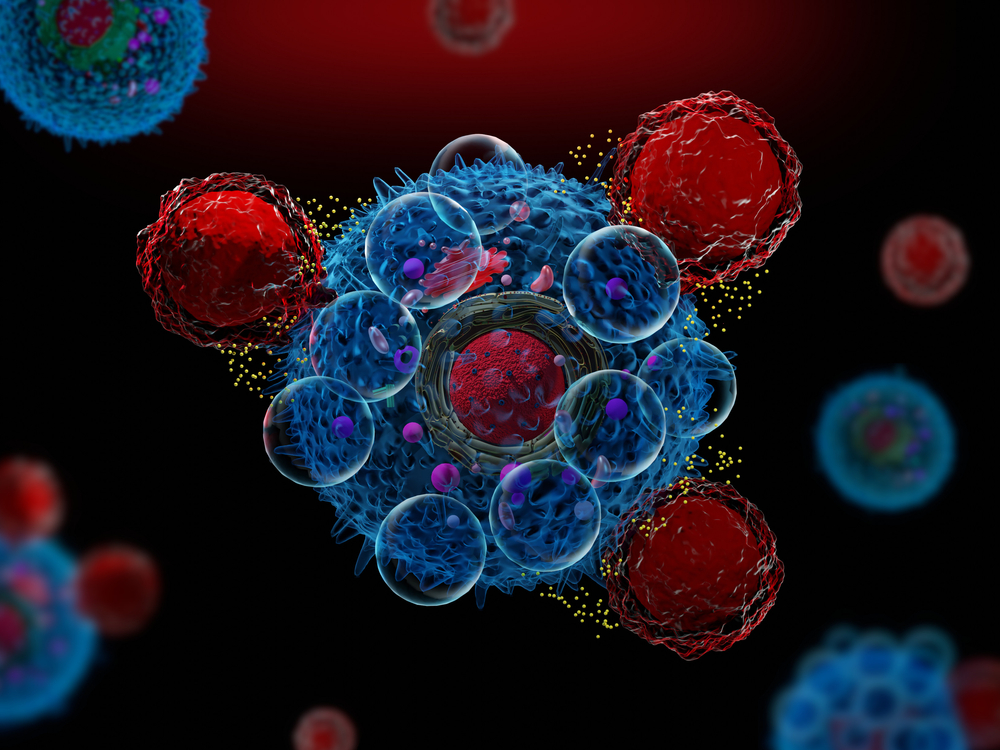Chimeric antigen receptor, or CAR, T cells have considerably improved cancer treatment outcomes for certain malignancies. CAR T cells are produced when T cells isolated from the patient are modified to target a specific antigen whose expression is increased on the cell surface of the patient’s cancer cells. The manufactured CAR T cells specifically eliminates cancer cells when injected back into the patient. However, CAR T cell generation is a labor-intensive, rigorous and costly procedure and progress towards optimizing their manufacture has been slow. In a recent study, published in the Journal of Immunotherapy, Drs. Sang Lee and Brian Till in the Clinical Research Division investigated ways to improve the procedure, specifically for targeting CD20-expressing B cells in non-Hodgkin B-cell Lymphoma patients.
The authors started by modifying an anti-CD20 CAR construct previously characterized by the group. Several aspects of the construct were optimized based on previous studies and validated in vitro and in vivo in mice xenografted (grafted with cells from a different species) with tumor cell lines, based on tumor size and mouse survival. For instance, an immunoglobulin G1 spacer domain in the CAR is needed to provide the optimal distance between the T cell and target cells to trigger CAR signaling. However, this space had been previously shown by the Riddell Lab to bind to Fc receptors in mice and lead to elimination of the CAR T cells by activation-induced cell death. By optimizing both the size and the sequence of this region the in vivo anti-tumor efficacy of the CAR T cells was improved. Additionally, the previous version of the construct contained an inducible caspase 9 suicide gene, which significantly increased the size of the vector insert and led to poor lentiviral titers. By removing this gene and thus reducing the size of the transgene to be integrated into the genome of the host T cells, the team improved the titers of the CAR-encoding lentiviruses as well as CAR function and expression levels in the transduced T cells.
With the goal to adapt the CAR for clinical applications and reduce immunogenicity issues, the CD20-binding region of the CAR, initially of murine origin, was replaced with a similar variable region but of human origin, also binding to CD20 epitope with the same efficiency, and successfully validated in vitro and in vivo. Additionally, using two instead of one co-stimulatory regions (third versus second-generation CAR, respectively) also increased CAR T cells function and persistence.
Several millions CAR T cells are commonly injected back into the patients. For this reason, the cells are modified first and then expanded for approximately two weeks. To this end, the T cells need to be stimulated. In most commercial CAR T cell processes stimulation with beads coupled anti-CD3 and -CD28 antibodies is the only stimulation step; however, cell expansion is not always adequate with this approach. One way to improve ex vivo T cell expansion is to re-stimulate the CAR expressing T cells through the CAR, allowing specific activation and expansion of the CAR-expressing T cells over non- expressing T cells. However, in some cases several stimulations can be excessive and exhaust the cells, leading to numerous but non-functional CAR T cells. To elucidate whether this could be the case with their CAR T cells, the authors noticed that despite lower in vitro cytokines secretion following co-culture with the targeted tumor cells, the CAR T cells that were re-stimulated with a CD20-expressing cell line were as functional as the cells stimulated only once in vivo, but expanded better.
Dr. Till added “One take-home lesson is that there are several variables (spacer length, which costimulatory domains, culture conditions) that can impact CAR T cell efficacy, and because there is currently no way to predict the optimal combination of these variables, it is necessary to test them empirically, and probably in a mouse model since in vitro tests like cytolytic function and cytokine secretion do not seem to correlate well with in vivo activity.”
Cryopreservation of the final CAR T cell product also presents benefits such as scheduling flexibility, more quality controls prior to infusing the cells back into the patient and is more compatible larger scale applications. “The question of what the impact of cryopreservation has on the function of a CAR T cell product is, I think, relevant to anyone in the CAR T cell field who wants to treat patients on a large scale, since the current model of central manufacturing and then shipping of cells to local sites is most feasible using cryopreserved cells”, explained Dr. Till. However, it can be a serious downside to cell viability and functions. The authors compared the efficiency of CAR T cells with or without cryopreservation. No significant difference in CAR expression levels, activation, cell differentiation, exhaustion, cytokines secretion was noted in vitro. Additionally, in vivo efficiency was similar between cryopreserved and non-cryopreserved CAR T cells.
The results from this study could benefit any CAR T cell project in the field beyond CD20. Dr. Till noted that his team has just started a clinical trial testing these optimized CD20 CAR T cells in patients: “we are excited to see whether the CAR we selected as the winner will prove to be effective in patients with relapsed or refractory lymphomas. It is one thing to cure mice of lymphoma, but it will be very exciting if we see that these CAR T cells can actually put lymphomas into remission in humans.”
This study was supported by the Giuliani Family Foundation, National Cancer Institute/ National Institutes of Health, the Damon Runyon Cancer Research Foundation, the Fred Hutch Shared Resources, Fred Hutch Recruitment Award NIDDK DK56465, and the Bezos family.
Lee SY, Olsen P, Lee DH, Kenoyer AL, Budde LE, O’Steen S, Green DJ, Heimfeld S,Jensen MC, Riddell SR, Press OW, Till BG. 2017. Preclinical Optimization of a CD20-specific Chimeric Antigen Receptor Vector and Culture Conditions. Journal of Immunotherapy. Jan;41(1):19-31.
Source: https://www.fredhutch.org/en/news/spotlight/2018/01/crd_till_immunoth.html

